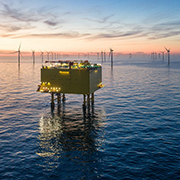- No new installations in the second half of 2020. A total of 1,501 turbines with a capacity of 7,770 MW on the grid – offshore wind delivers clean, safe and cost-effective electricity.
- Tendering of potentially usable areas required as soon as possible to enable earlier construction activities and thus preserve existing innovation potential, employment and the value chain in Germany.
- Use positive market dynamics through the EU strategy for renewable offshore energy, trigger investment push!
Berlin, 21 January 2021 – Today, the German offshore wind industry presented the expansion figures for offshore wind energy in 2020. According to these figures, 32 turbines with a capacity of 219 MW were connected to the grid for the first time last year. In total, 1,501 offshore wind turbines with a capacity of 7,770 MW are feeding electricity into the German North Sea and Baltic Sea. Due to incorrect political framework conditions, no new plants could be built in the second half of 2020.
“While the long-term framework conditions for the offshore wind industry have improved over the past year with the EU’s ‘Green Deal’ and the German government’s new long-term targets until 2040, the short-term situation of the industry remains challenging with the very weak domestic market,” industry organisations BWE, BWO, VDMA Power Systems, WAB and the OFFSHORE-WINDENERGIE Foundation commented on the offshore expansion figures for 2020 published today by Deutsche WindGuard.
Enable construction activities immediately, equalise expansion and strengthen the value chain
Numerous companies in the offshore wind industry are not only confronted with the challenges of internationalisation and the Corona crisis, but also with the outlook that not a single offshore wind turbine will be installed in German waters next year – after expansion in 2020 was already only 15 percent of the 2017 level.
The serious consequences of the lack of wind energy expansion in the North and Baltic Seas, such as company closures, employment losses and migration from the German market, which the industry has continuously warned about in recent years, must be overcome as quickly as possible. It makes sense to trigger a surge in investment now. This will secure the German offshore wind value chain. To this end, it is necessary to quickly implement the Coastal Sea Regulation proposed by the industry and to equalise the “expansion peak” in the years 2029 and 2030 towards the front. What is needed is a short-term stimulus for cost-efficient expansion. The modernisation and investment programme energy transition not only advances climate protection, it also makes Germany less dependent on energy imports, can be a job engine and offers great economic opportunities for innovative small and medium-sized enterprises in this country and on the global export markets.
To achieve this, the existing potential must be put out to tender as quickly as possible and combined with rapid commissioning. More new capacity should be added before the end of the decade. By this the German government’s expansion target of 20 gigawatts by 2030 can be safely achieved. “Bringing forward investments now helps the economy and climate protection in equal measure. Offshore wind power is essential as the foundation of the energy transition for German and European climate targets,” said the representatives of the industry associations.




























